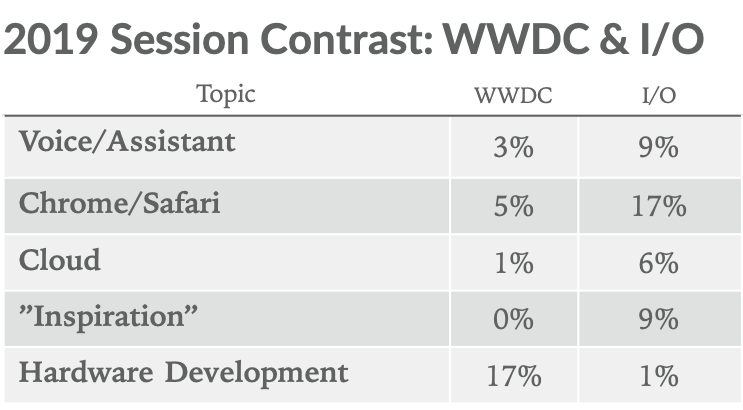WWDC and Google I/O set the direction for developers for the upcoming year and give insight to the trends Apple and Google are actively moving forward. The developer conference keynotes are the newsmakers but are only one event in a week of more than one hundred break-out sessions that detail a range of topics from how to program your first machine learning model to visual design and accessibility. We took a closer look at 326 sessions (WWDC 150 and Google 176 sessions) and found about 65% of the session themes overlap between the companies. These are topics that Apple and Google agree will shape the future. The remaining 35% of themes contrast their respective strengths and their visions of the future. Keep in mind some of these sessions covered topics spanning multiple themes. Here’s what we found:
The 65% They Agree On
Both are focused on helping developers design software that is secure and accessible to everyone, as well as integrating machine learning capabilities into their products. Within the gaming segment, Google is promoting the upcoming release of Stadia, while Apple continues to embrace augmented reality and its gaming opportunities.

Where Their Vision of the Future Differs
Apple continues to be a leader in hardware development. Conversely, Google had only two sessions related to hardware as it tweaked its hardware approach by recently announcing it will no longer produce tablets. Google remains focused on web/cloud-based apps, as well as building out the Assistant features. Another point of differentiation and new this year was Google “Inspiration” sessions to inspire developers to solve bigger, more complicated issues.

Google’s “Inspiration” Campaign
One topic unique to Google and absent at WWDC was an “inspiration” category. This accounted for 15 sessions out of 176 total I/O sessions. As mentioned, the concept around these break-outs was to inspire developers to solve bigger, more complicated issues. Examples of these bigger issues include crisis response, education, and economic opportunity. (“Using Technology to Change the World” and “Deep Learning to Solve Challenging Problems”).
Our sense is Google’s primary motivation behind the “inspiration” campaign is more than a response to the anti-tech movement. This appears to be a bigger goal for Google, evidenced by the level of resources committed to advancing inspiration directly to developers, as opposed to a branding exercise. It’s also loosely related to Google’s tradition of having employees spend 20% of their time working on side projects, some of which have grown into other bets that aim to solve hard problems including Calico (biology of aging), Verily (health data), and Waymo (self-driving cars).
Apple’s Inspiration Culture
Tim Cook recently gave the commencement address at Stanford and had a message for tech companies saying that “if you built a chaos factory, you can’t dodge responsibility for the chaos.” While this comment has been viewed as a criticism of Facebook, we believe Cook is speaking to a bigger theme for tech companies to reduce the damage they’ve done and in the future leverage their size and scale for good. This goal is aligned with Apple’s culture to inspire through designing and selling world-class consumer tech.
Disclaimer: We actively write about the themes in which we invest or may invest: virtual reality, augmented reality, artificial intelligence, and robotics. From time to time, we may write about companies that are in our portfolio. As managers of the portfolio, we may earn carried interest, management fees or other compensation from such portfolio. Content on this site including opinions on specific themes in technology, market estimates, and estimates and commentary regarding publicly traded or private companies is not intended for use in making any investment decisions and provided solely for informational purposes. We hold no obligation to update any of our projections and the content on this site should not be relied upon. We express no warranties about any estimates or opinions we make.
